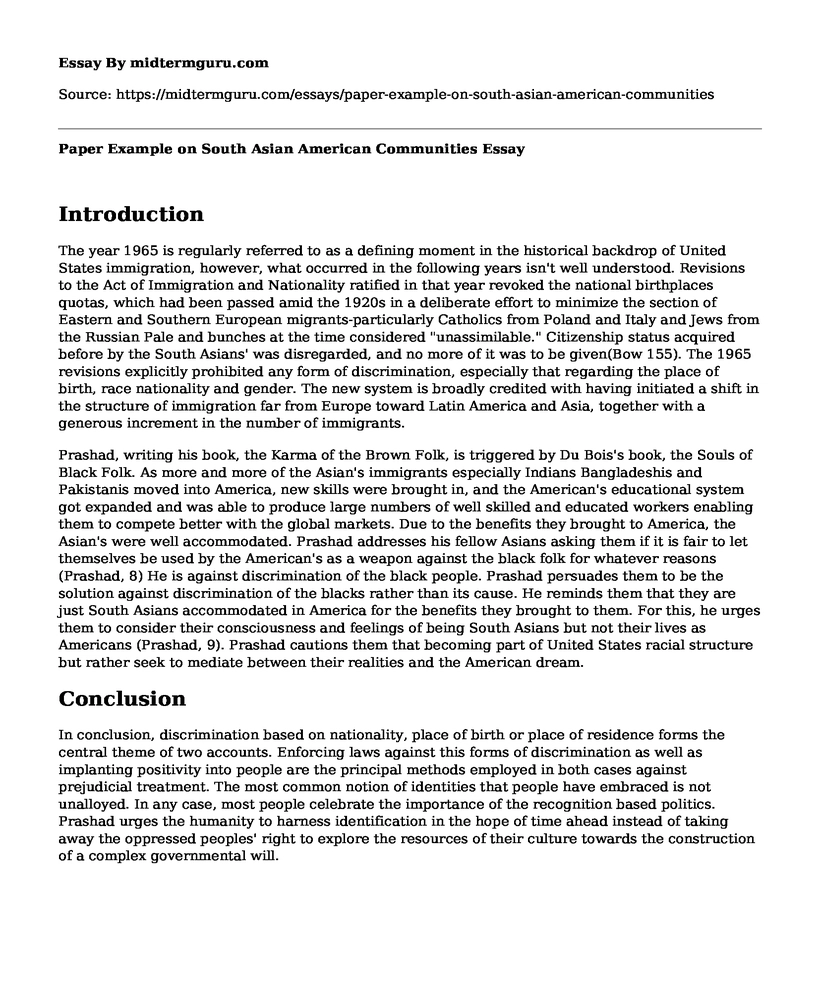Introduction
The year 1965 is regularly referred to as a defining moment in the historical backdrop of United States immigration, however, what occurred in the following years isn't well understood. Revisions to the Act of Immigration and Nationality ratified in that year revoked the national birthplaces quotas, which had been passed amid the 1920s in a deliberate effort to minimize the section of Eastern and Southern European migrants-particularly Catholics from Poland and Italy and Jews from the Russian Pale and bunches at the time considered "unassimilable." Citizenship status acquired before by the South Asians' was disregarded, and no more of it was to be given(Bow 155). The 1965 revisions explicitly prohibited any form of discrimination, especially that regarding the place of birth, race nationality and gender. The new system is broadly credited with having initiated a shift in the structure of immigration far from Europe toward Latin America and Asia, together with a generous increment in the number of immigrants.
Prashad, writing his book, the Karma of the Brown Folk, is triggered by Du Bois's book, the Souls of Black Folk. As more and more of the Asian's immigrants especially Indians Bangladeshis and Pakistanis moved into America, new skills were brought in, and the American's educational system got expanded and was able to produce large numbers of well skilled and educated workers enabling them to compete better with the global markets. Due to the benefits they brought to America, the Asian's were well accommodated. Prashad addresses his fellow Asians asking them if it is fair to let themselves be used by the American's as a weapon against the black folk for whatever reasons (Prashad, 8) He is against discrimination of the black people. Prashad persuades them to be the solution against discrimination of the blacks rather than its cause. He reminds them that they are just South Asians accommodated in America for the benefits they brought to them. For this, he urges them to consider their consciousness and feelings of being South Asians but not their lives as Americans (Prashad, 9). Prashad cautions them that becoming part of United States racial structure but rather seek to mediate between their realities and the American dream.
Conclusion
In conclusion, discrimination based on nationality, place of birth or place of residence forms the central theme of two accounts. Enforcing laws against this forms of discrimination as well as implanting positivity into people are the principal methods employed in both cases against prejudicial treatment. The most common notion of identities that people have embraced is not unalloyed. In any case, most people celebrate the importance of the recognition based politics. Prashad urges the humanity to harness identification in the hope of time ahead instead of taking away the oppressed peoples' right to explore the resources of their culture towards the construction of a complex governmental will.
Works Cited
Bow, Leslie. Partly Colored: Asian Americans and Racial Anomaly in the Segregated South. New York UP, 2010.
Prashad, V. The karma of Brown folk. University of Minnesota Press, 2000.
Cite this page
Paper Example on South Asian American Communities. (2022, Sep 07). Retrieved from https://midtermguru.com/essays/paper-example-on-south-asian-american-communities
If you are the original author of this essay and no longer wish to have it published on the midtermguru.com website, please click below to request its removal:
- Essay Sample on Diffusion of Innovation Theory
- Paper Example on Ethnic Discrimination
- Essay Sample on Importance of Intracompany User Guides
- Uncovering the Past: Public History and Historiography - Essay Sample
- Technology's Impact on Information Systems Careers - Essay Sample
- Dogs Are Better Than Cats: Controversial Essay
- Who Killed Reconstruction - Essay Sample







